仁爱版八年级英语下册知识树说课标说教材
- 格式:ppt
- 大小:725.00 KB
- 文档页数:19
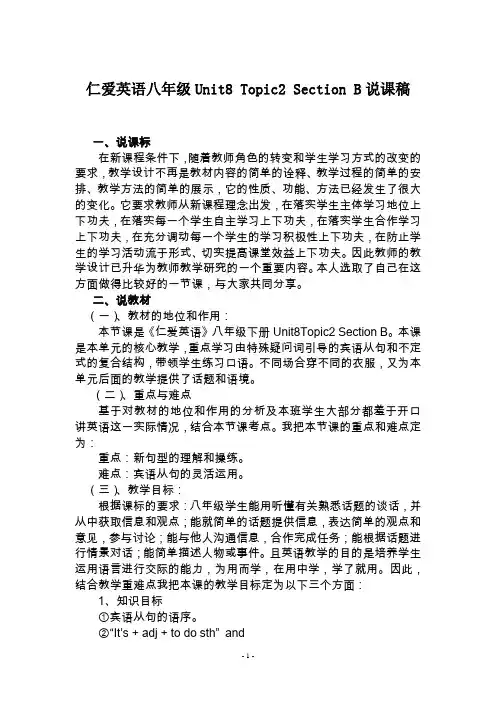
仁爱英语八年级Unit8 Topic2 Section B说课稿一、说课标在新课程条件下,随着教师角色的转变和学生学习方式的改变的要求,教学设计不再是教材内容的简单的诠释、教学过程的简单的安排、教学方法的简单的展示,它的性质、功能、方法已经发生了很大的变化。
它要求教师从新课程理念出发,在落实学生主体学习地位上下功夫,在落实每一个学生自主学习上下功夫,在落实学生合作学习上下功夫,在充分调动每一个学生的学习积极性上下功夫,在防止学生的学习活动流于形式、切实提高课堂效益上下功夫。
因此教师的教学设计已升华为教师教学研究的一个重要内容。
本人选取了自己在这方面做得比较好的一节课,与大家共同分享。
二、说教材(一)、教材的地位和作用:本节课是《仁爱英语》八年级下册Unit8Topic2 Section B。
本课是本单元的核心教学,重点学习由特殊疑问词引导的宾语从句和不定式的复合结构,带领学生练习口语。
不同场合穿不同的衣服,又为本单元后面的教学提供了话题和语境。
(二)、重点与难点基于对教材的地位和作用的分析及本班学生大部分都羞于开口讲英语这一实际情况,结合本节课考点。
我把本节课的重点和难点定为:重点:新句型的理解和操练。
难点:宾语从句的灵活运用。
(三)、教学目标:根据课标的要求:八年级学生能用听懂有关熟悉话题的谈话,并从中获取信息和观点;能就简单的话题提供信息,表达简单的观点和意见,参与讨论;能与他人沟通信息,合作完成任务;能根据话题进行情景对话;能简单描述人物或事件。
且英语教学的目的是培养学生运用语言进行交际的能力,为用而学,在用中学,学了就用。
因此,结合教学重难点我把本课的教学目标定为以下三个方面:1、知识目标①宾语从句的语序。
②“It’s + adj + to do sth”and“It’s + adj +that…。
③服装文化的学习和正确着装的引导。
2、能力目标在连贯的听、说、读、写活动中,训练学生的逻辑思维能力、快速反应能力和实践能力,使学生能熟练应用宾语从句。
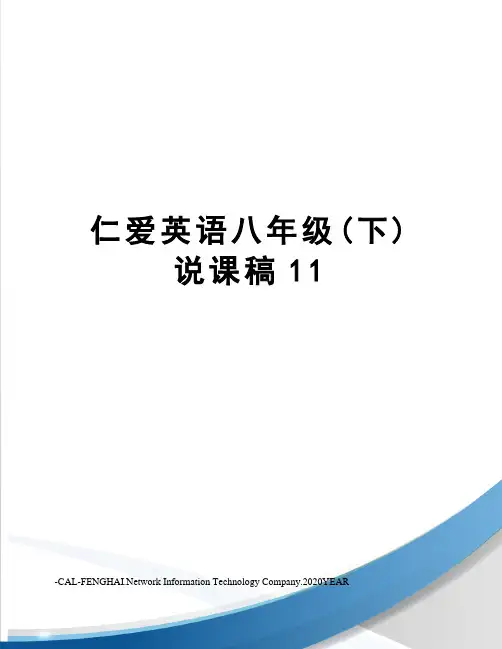
仁爱英语八年级(下)说课稿11work Information Technology Company.2020YEAR长坝中学英语公开课教案时间:2011年10月21日班级:七(2)班执教人:杨静主备课人:杨静参与人:丁远红杜玉科周远飞Topic 2 Cooking is fun!Section ASection A needs 1 period. Section A需用1课时。
The main activities are 1a and 2a. 本课重点活动是1a和2a。
Ⅰ.Aims and demands 目标要求1. (1)Learn adverbs of manner:finely, lightly, immediately(2)Learn other new words and phrases:cut, oil, add, cooker, pork, cut up, ham, noodle, bowl, advantage, cheap2. Know the ways to cook Chinese food:First, cut some cooked meat very finely.Next, you need to put some oil in the pan.Then fry the meat lightly.You need to add the rice slowly.Finally, add some salt.3. Talk about sequences:First … Second … Next … Then … After that … Finally …4. Learn object clauses with “whether”:But I’m not sure whether I can cook it well.Ⅱ.Teaching aids教具录音机/图片/彩笔/小黑板(幻灯片)Ⅲ.Five-finger Teaching Plan 五指教学方案Step 1 Review 第一步复习(时间:7分钟)复习食品名称,呈现本课的目标语言。
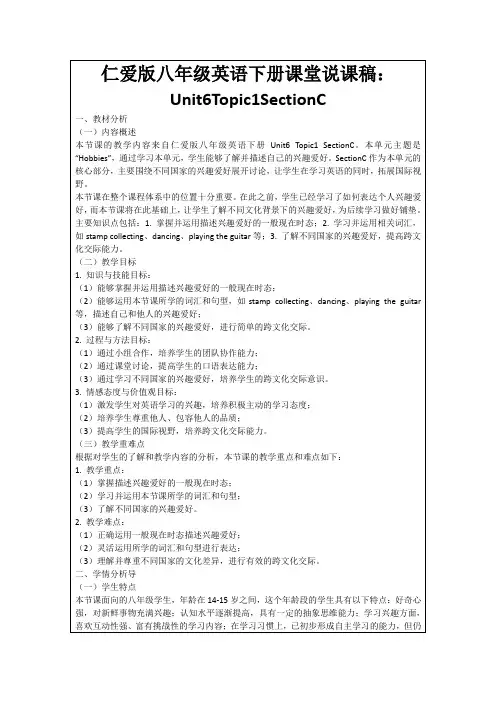
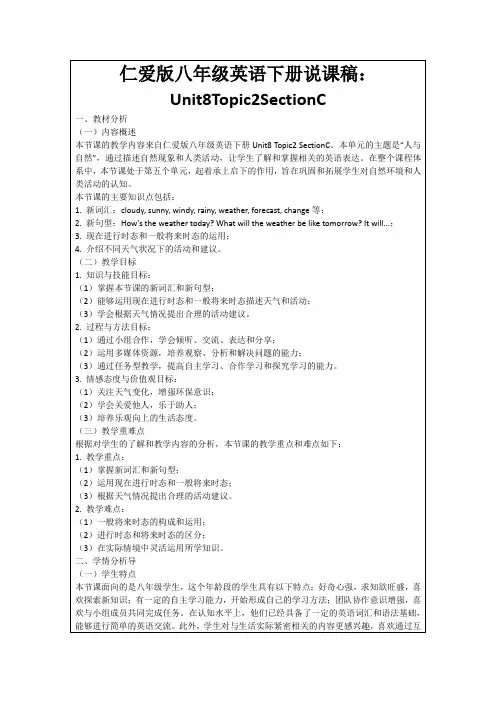
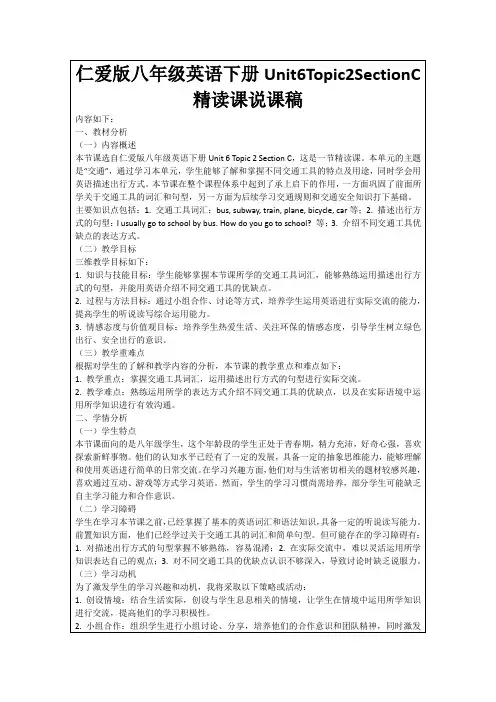

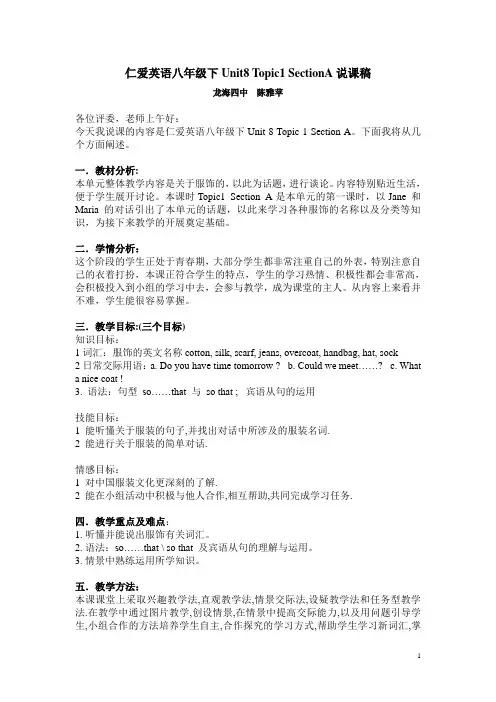
仁爱英语八年级下Unit8 Topic1 SectionA说课稿龙海四中陈雅苹各位评委,老师上午好:今天我说课的内容是仁爱英语八年级下Unit 8 Topic 1 Section A。
下面我将从几个方面阐述。
一.教材分析:本单元整体教学内容是关于服饰的,以此为话题,进行谈论。
内容特别贴近生活,便于学生展开讨论。
本课时Topic1 Section A是本单元的第一课时,以Jane 和Maria 的对话引出了本单元的话题,以此来学习各种服饰的名称以及分类等知识,为接下来教学的开展奠定基础。
二.学情分析:这个阶段的学生正处于青春期,大部分学生都非常注重自己的外表,特别注意自己的衣着打扮,本课正符合学生的特点,学生的学习热情、积极性都会非常高,会积极投入到小组的学习中去,会参与教学,成为课堂的主人。
从内容上来看并不难,学生能很容易掌握。
三.教学目标:(三个目标)知识目标:1词汇:服饰的英文名称cotton, silk, scarf, jeans, overcoat, handbag, hat, sock2日常交际用语:a. Do you have time tomorrow ? b. Could we meet……? c. Whata nice coat !3. 语法:句型so……that 与so that ; 宾语从句的运用技能目标:1 能听懂关于服装的句子,并找出对话中所涉及的服装名词.2 能进行关于服装的简单对话.情感目标:1 对中国服装文化更深刻的了解.2 能在小组活动中积极与他人合作,相互帮助,共同完成学习任务.四.教学重点及难点:1. 听懂并能说出服饰有关词汇。
2. 语法:so……that \ so that 及宾语从句的理解与运用。
3. 情景中熟练运用所学知识。
五.教学方法:本课课堂上采取兴趣教学法,直观教学法,情景交际法,设疑教学法和任务型教学法.在教学中通过图片教学,创设情景,在情景中提高交际能力,以及用问题引导学生,小组合作的方法培养学生自主,合作探究的学习方式,帮助学生学习新词汇,掌握重点语法内容,让学生在"做中学,学中做".六.教具:多媒体课件、卡片、录音机七.教学步骤第一步:导入(5分钟)1. 展示一张服装秀的图片,引出本课的话题。
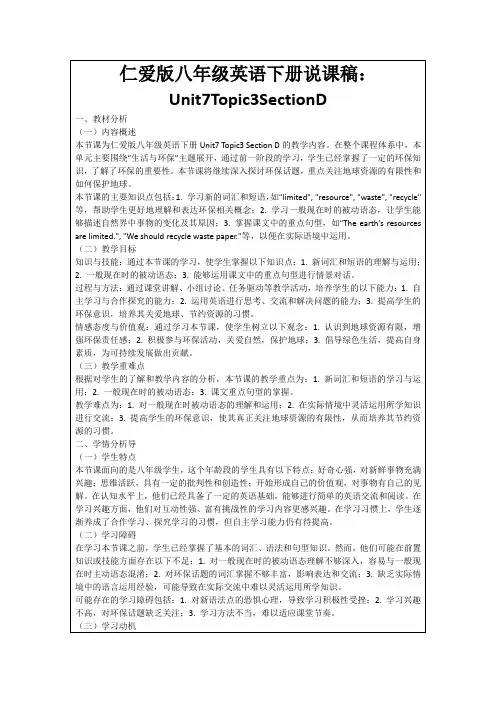
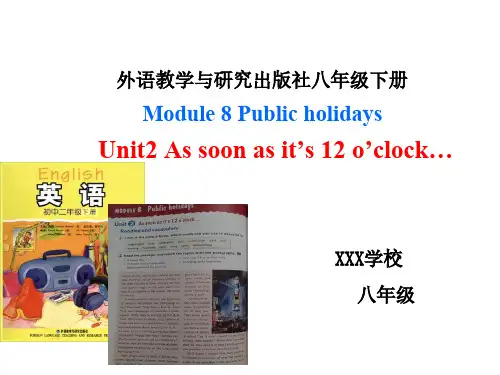
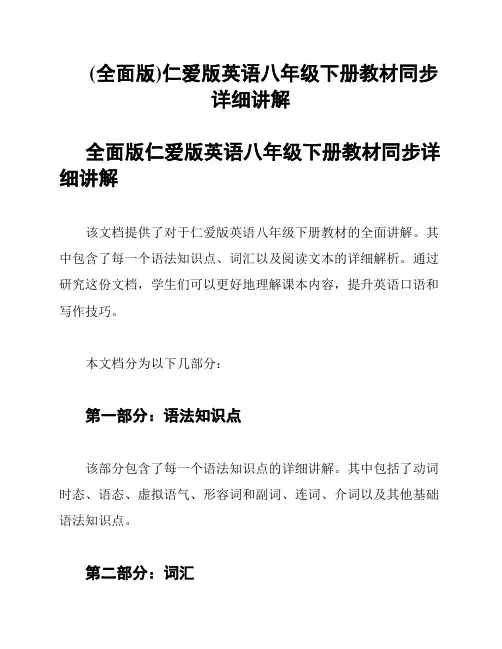
(全面版)仁爱版英语八年级下册教材同步
详细讲解
全面版仁爱版英语八年级下册教材同步详细讲解
该文档提供了对于仁爱版英语八年级下册教材的全面讲解。
其中包含了每一个语法知识点、词汇以及阅读文本的详细解析。
通过研究这份文档,学生们可以更好地理解课本内容,提升英语口语和写作技巧。
本文档分为以下几部分:
第一部分:语法知识点
该部分包含了每一个语法知识点的详细讲解。
其中包括了动词时态、语态、虚拟语气、形容词和副词、连词、介词以及其他基础语法知识点。
第二部分:词汇
该部分详细讲解了课本中每一个单词的意思以及用法。
通过研究这一部分,学生们可以更好地理解和运用这些单词。
第三部分:阅读文本详解
该部分提供了每一个阅读文本的详细解析。
其中包括了每一个生词的解释,以及针对文章中的关键句子和段落的讲解和解析。
通过阅读这份文档,学生们可以更好地掌握仁爱版英语八年级下册教材中的所有知识点和技巧。
同时,这份文档也可以作为学生们日常学习和考试复习的重要参考资料。
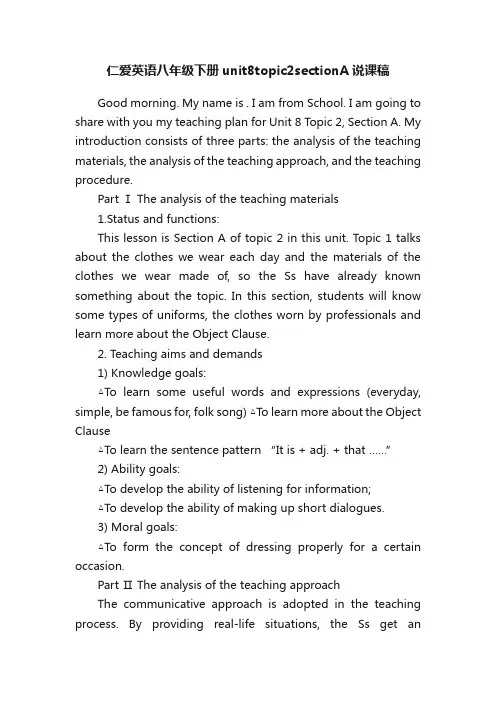
仁爱英语八年级下册unit8topic2sectionA说课稿Good morning. My name is . I am from School. I am going to share with you my teaching plan for Unit 8 T opic 2, Section A. My introduction consists of three parts: the analysis of the teaching materials, the analysis of the teaching approach, and the teaching procedure.Part Ⅰ The analysis of the teaching materials1.Status and functions:This lesson is Section A of topic 2 in this unit. Topic 1 talks about the clothes we wear each day and the materials of the clothes we wear made of, so the Ss have already known something about the topic. In this section, students will know some types of uniforms, the clothes worn by professionals and learn more about the Object Clause.2. Teaching aims and demands1) Knowledge goals:△To learn some useful words and expressions (everyday, simple, be famous for, folk song) △T o learn more about the Object Clause△To learn the sentence pattern “It is + adj. + that ……”2) Ability goals:△To develop the ability of listening for information;△To develop the ability of making up short dialogues.3) Moral goals:△To form the concept of dressing properly for a certain occasion.Part Ⅱ The analysis of the teaching approachThe communicative approach is adopted in the teaching process. By providing real-life situations, the Ss get anopportunity to apply what they are learning, which is the basic aim of any language teaching. The Ss not only learn about the language, but also learn to use the language in this class.In accordance with the notion of “learning through doing” and “learning through using”, enough chances to practice, such as pair work, group work are provided so that the Ss take an active part throughout the teaching process.Part III The analysis of the teaching procedureStep 1 Review (5’)Present the Ss with a picture of a coat, and ask the Ss to talk about the color, size and material of the coat. Then invite one student to talk about the clothes he wears and another student to decide whether it’s proper for the student to wear clothes like that, and then naturally lead to the topic of uniforms. Then present the Ss with more pictures of peoplewearing uniforms. Ask the Ss who usually wear each uniform and why they wear uniforms.Step 2 Presentation (8’)1.Listen to 1a and answer the following question: can Miss Wang allow her students to design their own uniforms?2.Listen to 1a again, and ask the Ss to mark the key words and phrases. Explain the usage of the key words and phrases.3. Ask the students to find out sentences with Object Clause.Step 3 Consolidation (15’)1. Ask the Ss to act out 1a with the help of the key words.2. Activity: what does he/she ask?Ask the students to study the example in 1b to make sure all the students know what they are expected to do. Divide the class into groups of three. One student asks a question, the second student asks the third student “what does he/she ask?”, andthe third student answers the question. Then they switch roles. This activity aims to practice the Object Clause beginning with wh- words. Invite one group to act out their dialogue in front of the class.3.Activity: what should he/she wear …?Now the students know that on different occasions, different kinds of clothes should be worn. List as much kinds of clothes as possible. Imagine six occasions, at the office, in winter, at home, on the Great Wall, in the park, on windy days. Ask the students what kind of clothes should people wear on those occasions. Divide the class into groups of two. Ask the students to make up dialogues following the example in 3 and act them out. Then invite some groups to act out their dialogue in front of the class.Step 4 Practice (12’)1. Listen to 2a and answer the question: when do the police wear uniforms?2. Read the dialogue and find out the reasons why the police wear uniforms when they are at work.3. Mark the key words, “suitable”, “find us easily”, “stop …from…”. Ask the students to repeat the policewoman’s answer with the help of the key words.Step 5 Project (5’)Divide the class into pair of three. Imagine one student is a doctor/teacher/soldier … The second student interviews his partner by asking “Is it important for you to wear uniforms at work?” The third student repeats the answer by saying “He/she says …”That’s all for my introduction. I sincerely welcome your suggestions. Thanks for your time.。
仁爱版八年级下册unit2英语说课稿范文全文共3篇示例,供读者参考篇1Unit 2 of the 8th grade English textbook from Ren'ai Edition focuses on the theme of food and health. In this unit, students will learn vocabulary related to food, cooking methods, and healthy eating habits. They will also practice using these words in speaking and writing exercises, as well as reading and listening comprehension activities.To start the lesson, I will begin by introducing the topic of food and health to the students. I will ask them questions such as "What is your favorite type of food?" and "What do you think makes a healthy meal?" This will help to engage the students and get them thinking about the importance of food in their lives.Next, I will present the new vocabulary to the students. I will use flashcards, pictures, and examples to help them understand the words and how to use them in sentences. I will also provide pronunciation practice so that the students can confidently say the words aloud.After that, I will move on to the grammar point for this unit, which is using "should" to give advice. I will explain the structure of the sentence (subject + should + base verb) and give examples of how to use it in context. I will then have the students practice forming sentences with "should" using the new vocabulary they have learned.In the reading and listening activities, students will read and listen to passages about healthy eating habits and food choices. They will answer comprehension questions and discuss their own opinions on the topics. This will help them to improve their reading and listening skills, as well as give them a chance to express their thoughts in English.For the speaking and writing exercises, students will work in pairs or small groups to have conversations about food and health. They will discuss their favorite dishes, cooking methods, and the importance of eating well. They will also write short paragraphs or essays about a healthy meal they enjoy and why it is beneficial for their health.To wrap up the lesson, I will review the key vocabulary and grammar points with the students. I will also encourage them to continue practicing their English outside of the classroom byreading English books, watching English movies, and listening to English songs.Overall, Unit 2 of the 8th grade English textbook from Ren'ai Edition provides students with a comprehensive understanding of food and health vocabulary, grammar, reading, listening, speaking, and writing skills. I am confident that the students will enjoy this lesson and find it useful for their English language learning journey. Thank you.篇2Unit 2 of the 8th grade Ren'ai edition covers the theme of "Cultural relics". In this unit, students will learn about different cultural relics around the world, ways to protect cultural relics, and the importance of cultural relics in preserving history and heritage.The unit is divided into four parts: Reading, Language Points, Grammar, and Writing. Each part contains various activities and exercises to help students practice their English skills and deepen their understanding of the topic.In the Reading section, students will read a text about the Terracotta Warriors in China. They will learn about the history of the warriors, how they were discovered, and why they areconsidered a significant cultural relic. There are also comprehension questions and vocabulary exercises to help students improve their reading comprehension and expand their vocabulary.The Language Points section focuses on key vocabulary and phrases related to cultural relics. Students will learn words like archaeology, preservation, and conservation, as well as how to use them in sentences. This section also includes activities such as matching exercises and fill-in-the-blank questions to reinforce students' understanding of the vocabulary.The Grammar section covers the passive voice, which is commonly used when talking about cultural relics and historical events. Students will learn how to form and use the passive voice in sentences, as well as when to use it in different situations. There are also practice exercises to help students master this grammar point.In the Writing section, students will be asked to write a short paragraph about their favorite cultural relic and why it is important to them. This activity allows students to express their opinions and practice their writing skills in English.Overall, Unit 2 provides students with a comprehensive overview of cultural relics and encourages them to think criticallyabout the importance of preserving and protecting these valuable artifacts. Through reading, listening, speaking, and writing exercises, students will develop their English language skills and deepen their understanding of this fascinating topic.篇3说课稿Unit 2 Healthy eating, healthy livingGood morning, everyone. Today I am going to introduce Unit 2 "Healthy eating, healthy living" from Ren'ai Version Grade 8. This unit focuses on the importance of maintaining a balanced diet and leading a healthy lifestyle. It covers topics such as different types of food, the benefits of exercise, and the consequences of an unhealthy diet.First, let's look at the objectives of this unit. By the end of this unit, students should be able to:1. Identify different types of food and their nutritional value.2. Explain the benefits of eating a balanced diet.3. Describe the importance of regular exercise for overall health.4. Discuss the consequences of an unhealthy diet on the body.The unit is divided into five sections:1. A balanced diet2. Healthy breakfast3. Junk food versus healthy food4. Benefits of exercise5. The consequences of an unhealthy dietIn the first section, students will learn about the different food groups and the importance of including a variety of foods in their diet. They will also learn how to create a balanced meal using the food pyramid as a guide.The second section focuses on the importance of starting the day with a healthy breakfast. Students will learn about the benefits of eating a nutritious breakfast and the consequences of skipping this meal.In the third section, students will compare and contrast junk food with healthy food. They will learn about the negative effects of consuming too much junk food and the benefits of choosing healthier options.The fourth section explores the benefits of exercise for overall health. Students will learn about the different types of exercise and how they can incorporate physical activity into their daily routine.Finally, in the fifth section, students will discuss the consequences of an unhealthy diet on the body. They will learn about the health risks associated with eating too much sugar, salt, and fat.Throughout the unit, students will engage in a variety of activities such as group discussions, role-plays, and research projects to reinforce their understanding of the material.In conclusion, Unit 2 "Healthy eating, healthy living" is an important unit that teaches students the importance of maintaining a balanced diet and leading a healthy lifestyle. By the end of this unit, students will have a better understanding of how their food choices and lifestyle habits impact their overall health and well-being.Thank you for listening. If you have any questions, please feel free to ask.。
仁爱八年级英语下册Unit5Topic1 SectionB说课稿一、教材分析1、地位与作用2.教学目标(1).知识目标(2).技能目标:(3).情感目标学会表达自己的情感或他人的情感。
3.教学重点和难点(1)重点:学会如何表达自己的情感或他人的情感。
掌握连系动词+形容词构成系表结构的用法。
(2)难点:连系动词+形容词构成系表结构的用法。
二. 说教法:对本课我主要采取了如下几种教法:1. 任务型教学法:设置面向全体,贴近生活的任务,让学生在完成任务的过程中体验成功的喜悦,从而达到乐中求学的目的。
2. 有趣的情景教学法:通过创造各种较贴近生活实际,自然愉悦又令学生感兴趣的情景进行教学,为学生创设轻松愉快的学习气氛,使他们处于最佳的学习状态。
3. 竞赛教学法:通过背单词、提问抢答、朗读、听力比赛,激发学生学习的强烈兴趣,给学生创造语言气氛,轻松快乐地学英语。
4. 互动教学法:互动教学的开展主要靠教师引导学生有效参与来实现。
教师启动,学生自学,组内讨论,组间交流,效果评价。
四、说学法:我所采用的教学法有助于学生掌握如下学法:1. 英语交际:把所学的交际英语进行英语交际。
培养语言的综合运用能力。
2. 科学储备大量英语知识:狠抓基础,注意密度。
没有足够的词汇量,没有熟知语法规则,不了解语言规律就不可能进行很好的语言交流,为用而学,学了就用,用中学,学中用。
把英语进行到底。
3. 反思与实践:无论在课堂上,还是在课堂外,都要让学生积极参与每个教学活动,课外反复操练,大胆开口,创造性地说自己想说的话,及时整理语言难点,再次认识并积极使用。
温故知新,克服遗忘。
4. 注意培养自学能力。
精品文档Unit 5 Topic 3 Section C 说课稿一、教材分析:1、教材的地位及作用:《仁爱英语》教材的语言教育理念是:强调语言的实际应用,培养学生的“创新、实践能力”,发展“学习策略”。
2、单元分析及教材处理本节课选自八年级下学期Unit5Topic3 Many things can affect our feelings .Section C。
这是第五单元第三课题的第三课时,在通过前两个情景对情感谈论的学习后本情景教学引出外界事物对情感的影响。
教学的内容以活动的形式呈现,密切联系生活实际,把英语教学和情感教育有机地结合起来。
由关心他人情感到注重自我心理健康,将英语知识和实际生活联系起来。
2、教学目标:(1)语言技能目标和学生能力发展目标:听:能听懂较熟悉的关于个人情感的话题材料并从中获取所需信息。
说:能在教师的帮助下或根据图片用简单的语言描述自己或他人的情感。
读:能读懂关于情感方面的语言材料。
写:能在教师的帮助下或通过小组讨论后起草作文。
3、情感目标:教育学生注意并理解他人的情感,同时保持乐观的心态。
4、重点与难点:重点:学生能够真确掌握本话题句式及复习巩固重点短语。
难点:运用综合语言知识对外界事物在情感上的影响进行准确的描述。
二、教学方法:精品文档.精品文档为充分调动学生的积极性,本节课我充分利用多媒体教学。
采用情景教学法和互动教学法来完成教学任务,通过我创设的情景画面展开师生之间、生生之间、生与媒体之间的全方位互动。
在整个教学过程中情景的创设、活动的开展、各种互动式的融合贯穿教学始终。
把学生置身于语言学习的浓厚氛围中,在活动中培养学生协作式的学习能力,使英语教学大容量、快节奏、高效率的特点得到充分体现。
三、教学流程1.视频发动,激发兴趣。
2.快速回顾,边演边说3.呈现课文,解决要点4.看图复述,巩固提高5.综合探究,主题升华四、板书设计SectionCWhenever you meet difficulties , try to smile at life!1. affect Review:精品文档.精品文档eg: Many things around us can affect our feelings. make + object+adj./v.2. fill with= be full of 充满fill with3. thoughteg: I always have interesting thoughts .精品文档.。